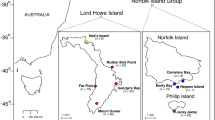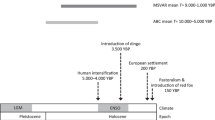Abstract
The history of population structure is a key to effective wildlife management and conservation. However, inferring the history of population structure using present genetic structures is problematic when the method is applied to species that have experienced severe population bottlenecks. Ancient DNA analysis seemed to be a promising, direct method for inferring ancient population structures. However, the usual methods for inferring modern population structure, i.e. the phylogeographic approach using mitochondrial DNA and the Bayesian approach using microsatellite DNA, are often unsuitable for ancient samples. In this study, we combined ancient DNA obtained from zooarchaeological bones with carbon/nitrogen stable isotope ratios and morphological variations to infer ancient population structure of the short-tailed albatross Phoebastria albatrus. The results showed that the bird existed in two populations, between which the genetic distance was greater than that of distinct sister albatross species, although no subspecies of P. albatrus have been proposed. Our results suggest that the birds at the present two breeding regions (Torishima in the Izu Islands and two islets of the Senkaku Islands) are descended from these two ancient populations, and that reevaluation of the status and conservation strategy for the species is required. Our results also indicate that lineage breeding on the Senkaku Islands has drastically reduced genetic diversity, while that on Torishima has not. The approach proposed in this study would be useful for inferring ancient population structure, using samples of highly mobile animals and/or samples from archaeological sites, and the reconstructed ancient population structure would be useful for conservation and management recommendations.



Similar content being viewed by others
References
Abbott CL, Double MC (2003) Phylogeography of shy and white-capped albatrosses inferred from mitochondrial DNA sequences: implications for population history and taxonomy. Mol Ecol 12:2747–2758. doi:10.1046/j.1365-294X.2003.01944.x
Avise JC (2000) Phylogeography: the history and formation of species. Harvard University Press, Cambridge
Avise JC, Arnold J, Ball RM, Bermingham E, Lamb T, Neigel JE, Reeb CA, Saunders NC (1987) Intraspecific phylogeography—the mitochondrial-DNA bridge between population-genetics and systematics. Annu Rev Ecol Syst 18:489–522
BirdLife International (2008) Phoebastria albatrus. www.iucnredlist.org. Accessed 22nd July 2009
Burg TM, Croxall JP (2001) Global relationships amongst black-browed and grey-headed albatrosses: analysis of population structure using mitochondrial DNA and microsatellites. Mol Ecol 10:2647–2660
Burg TM, Croxall JP (2004) Global population structure and taxonomy of the wandering albatross species complex. Mol Ecol 13:2345–2355. doi:10.1111/j.1365-294X.2004.02232.x
Chamberlain CP, Blum JD, Holmes RT, Feng XH, Sherry TW, Graves GR (1997) The use of isotope tracers for identifying populations of migratory birds. Oecologia 109:132–141
Clegg SM, Kelly JF, Kimura M, Smith TB (2003) Combining genetic markers and stable isotopes to reveal population connectivity and migration patterns in a Neotropical migrant, Wilson’s warbler (Wilsonia pusilla). Mol Ecol 12:819–830
Clement M, Posada D, Crandall KA (2000) TCS: a computer program to estimate gene genealogies. Mol Ecol 9:1657–1659
Crandall KA, Bininda-Emonds ORP, Mace GM, Wayne RK (2000) Considering evolutionary processes in conservation biology. Trends Ecol Evol 15:290–295
DeNiro MJ (1985) Postmortem preservation and alteration of in vivo bone collagen isotope ratios in relation to palaeodietary reconstruction. Science 317:806–809
Deniro MJ, Epstein S (1978) Influence of diet on distribution of carbon isotopes in animals. Geochim Cosmochim Acta 42:495–506
Deniro MJ, Epstein S (1981) Influence of diet on the distribution of nitrogen isotopes in animals. Geochim Cosmochim Acta 45:341–351
Development Core Team R (2009) R: a language and environment for statistical computing., 2.10.1 edn. R Foundation for Statistical Computing, Vienna
Driesch A (1976) A guide to the measurements of animal bones from archaeological sites. Peabody Museum Bull 1:1–136
Eda M, Koike H, Sato F, Higuchi H (2005) Why were so many albatross remains found in northern Japan? In: Grupe G, Peters J (eds) Feathers, grit and symbolism: birds and humans in the old and new worlds. Verlag Marie Leidorf GmbH, Westfalen, pp 131–140
Eda M, Baba Y, Koike H, Higuchi H (2006) Do temporal size differences influence species identification of archaeological albatross remains when using modern reference samples? J Archaeol Sci 33:349–359. doi:10.1016/j.jas.2005.07.017
Eda M, Kuro-o M, Higuchi H, Hasegawa H, Koike H (2010) Mosaic gene conversion after a tandem duplication of mtDNA sequence in Diomedeidae (albatrosses). Genes Genet Syst 85:129–139
Excoffier L, Schneider S (1999) Why hunter-gatherer populations do not show signs of Pleistocene demographic expansions. Proc Natl Acad Sci USA 96:10597–10602
Fox CW, Roff DA, Fairbairn DJ (2001) Evolutionary ecology. Oxford University Press, Oxford
Futuyma DJ (1986) Evolutionary Biology. Sinauer Association Inc., Sunderland
Hadly EA, Kohn MH, Leonard JA, Wayne RK (1998) A genetic record of population isolation in pocket gophers during Holocene climatic change. Proc Natl Acad Sci USA 95:6893–6896
Hardy C, Callou C, Vigne JD, Casane D, Dennebouy N, Mounolou JC, Monnerot M (1995) Rabbit mitochondrial DNA diversity from prehistoric to modern times. J Mol Evol 40:227–237
Hartl DL, Clark AG (1997) Principles of population genetics. Sinauer Association Inc., Sunderland
Hasegawa H (2003) From fifty to five thousands: for the restoration of the short-tailed albatross. Doubutsu-sha, Tokyo (in Japanese)
Hobson KA (1999) Tracing origins and migration of wildlife using stable isotopes: a review. Oecologia 120:314–326
Hobson KA, Wassenaar LI (1997) Linking breeding and wintering grounds of Neotropical migrant songbirds using stable hydrogen isotopic analysis of feathers. Oecologia 109:142–148
Hofreiter M, Jaenicke V, Serre D, von Haeseler A, Paabo S (2001) DNA sequences from multiple amplifications reveal artifacts induced by cytosine deamination in ancient DNA. Nucleic Acids Res 29:4793–4799
Inchausti P, Weimerskirch H (2002) Dispersal and metapopulation dynamics of an oceanic seabird, the wandering albatross, and its consequences for its response to long-line fisheries. J Animal Ecol 71:765–770
Jaenicke-Despres V, Buckler ES, Smith BD, Gilbert MTP, Cooper A, Doebley J, Paabo S (2003) Early allelic selection in maize as revealed by ancient DNA. Science 302:1206–1208
Klicka J, Zink RM, Barlow JC, McGillivray WB, Doyle TJ (1999) Evidence supporting the recent origin and species status of the Timberline Sparrow. Condor 101:577–588
Knowles LL, Maddison WP (2002) Statistical phylogeography. Mol Ecol 11:2623–2635
Kuro-o M, Yonekawa H, Saito S, Eda M, Higuchi H, Koike H, Hasegawa H (2010) Unexpectedly high genetic diversity of mtDNA control region through severe bottleneck in vulnerable albatross Phoebastria albatrus. Conserv Genet 11:127–137
Lawrence HA, Scofield RP, Crockett DE, Millar CD, Lambert DM (2008) Ancient genetic variation in one of the world’s rarest seabirds. Heredity 101:543–547. doi:10.1038/hdy.2008.85
Leonard JA (2008) Ancient DNA applications for wildlife conservation. Mol Ecol 17:4186–4196. doi:10.1111/j.1365-294X.2008.03891.x
Librado P, Rozas J (2009) DnaSP v5: a software for comprehensive analysis of DNA polymorphism data. Bioinformatics 25:1451–1452. doi:10.1093/bioinformatics/btp187
Lott CA, Meehan TD, Heath JA (2003) Estimating the latitudinal origins of migratory birds using hydrogen and sulfur stable isotopes in feathers: influence of marine prey base. Oecologia 134:505–510. doi:10.1007/s00442-002-1153-8
Maeda U, Yamaura K (1992) Excavation research of Hamanaka 2 site. Maeda Insatsu, Tsukuba (in Japanese)
Mihara S, Okuno M, Ogawa H, Tanaka K, Nakamura T, Koike H (2002) AMS 14-C dating and dietary analysis for Lal-lo shell midden sites, Philippines. Summ Res Using AMS Nagoya Univ 13:82–104 (in Japanese)
Moore PJ, Taylor GA, Amey JM (1997) Interbreeding of black-browed albatross Diomedea m. melanophris and New Zealand black-browed albatross D. m. impavida on Campbell Island. Emu 97:322–324
Moritz C (1994) Defining evolutionarily significant units for conservation. Trends Ecol Evol 9:373–375
Pritchard JK, Stephens M, Donnelly P (2000) Inference of population structure using multilocus genotype data. Genetics 155:945–959
Prum B, Guilloudbataille M, Clergetdarpoux F (1990) On the use of chi-2 tests for nested categorized data. Ann Hum Genet 54:315–320
Rains D, Weimerskirch H, Burg TM (2011) Piecing together the global population puzzle of wandering albatrosses: genetic analysis of the Amsterdam albatross Diomedea amsterdamensis. J Avian Biol 42:69–79. doi:10.1111/j.1600-048X.2010.05295.x
Ramakrishnan U, Hadly EA (2009) Using phylochronology to reveal cryptic population histories: review and synthesis of 29 ancient DNA studies. Mol Ecol 18:1310–1330. doi:10.1111/j.1365-294X.2009.04092.x
Rasmussen PC (1994) Geographic-variation in morphology and allozymes of south-american imperial shags. Auk 111(1):143–161
Rosenberg NA, Pritchard JK, Weber JL, Cann HM, Kidd KK, Zhivotovsky LA, Feldman MW (2002) Genetic structure of human populations. Science 298:2381–2385
Shepherd LD, Millar CD, Ballard G, Ainley DG, Wilson PR, Haynes GD, Baroni C, Lambert DM (2005) Microevolution and mega-icebergs in the Antarctic. Proc Natl Acad Sci USA 102:16717–16722. doi:10.1073/pnas.0502281102
Tamura K, Dudley J, Nei M, Kumar S (2007) MEGA4: molecular evolutionary genetics analysis (MEGA) software version 4.0. Mol Biol Evol 24:1596-1599. doi:10.1093/molbev/msm092
Templeton AR (1993) The “Eve” hypothesis: a genetic critique and reanalysis. Am Anthropol 95:51–72
Templeton A, Georgiadis RNJ (1995) A landscape approach to conservation genetics: conserving evolutionary processes in the African Bovidae. In: Avise JC, Hamrick JL (eds) Conservation genetics. Chapman & Hall, New York, pp 398–430
Templeton AR, Sing CF (1993) A cladistic-analysis of phenotypic associations with haplotypes inferred from restriction endonuclease mapping. IV. nested analyses with cladogram uncertainty and recombination. Genetics 134:659–669
Templeton AR, Sing CF, Kessling A, Humphries S (1988) A cladistic analysis of phenotype associations with haplotypes inferred from restriction endonuclease mapping. II. The analysis of natural populations. Genetics 120:1145–1154
Templeton AR, Routman E, Phillips CA (1995) Separating population structure from population history: a cladistic analysis of the geographical distribution of mitochondrial DNA haplotypes in the tiger salamander, Ambystoma tigrinum. Genetics 140:767–782
Tickell WLN (2000) Albatrosses. Yale University Press, New Haeven
U. S. Fish and Wildlife Service (2008) Short-tailed albatross recovery plan.1-105
Webster MS, Marra PP, Haig SM, Bensch S, Holmes RT (2002) Links between worlds: unraveling migratory connectivity. Trends Ecol Evol 17:76–83
Acknowledgements
We thank Dr. Ushio Maeda for use of the albatross bones from HM2. We also thank Drs. Go Fujita, Tadashi Miyashita, Gregory Balogh, Haruki Tatsuta, Yoko Kunitake, Masaki Fujita, and Tatsuya Amano for their insightful comments on the manuscript and Dr. Van’t Hof and Jiro Eda for improving our English. Helpful comments from two anonymous reviewers clarified the strengths and weaknesses of this study. This study was supported financially in part by a Grant-in-Aid for JSPS Fellows to ME from the Japan Society for the Promotion of Science (No. 16-6316).
Author information
Authors and Affiliations
Corresponding author
Electronic supplementary material
Below is the link to the electronic supplementary material.
Rights and permissions
About this article
Cite this article
Eda, M., Koike, H., Kuro-o, M. et al. Inferring the ancient population structure of the vulnerable albatross Phoebastria albatrus, combining ancient DNA, stable isotope, and morphometric analyses of archaeological samples. Conserv Genet 13, 143–151 (2012). https://doi.org/10.1007/s10592-011-0270-5
Received:
Accepted:
Published:
Issue Date:
DOI: https://doi.org/10.1007/s10592-011-0270-5




